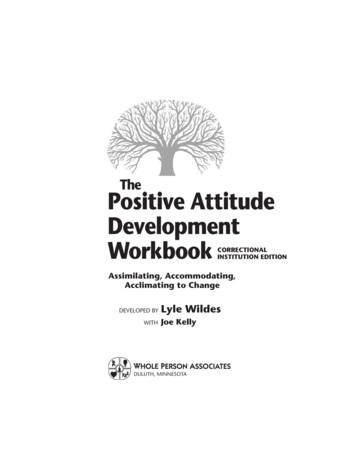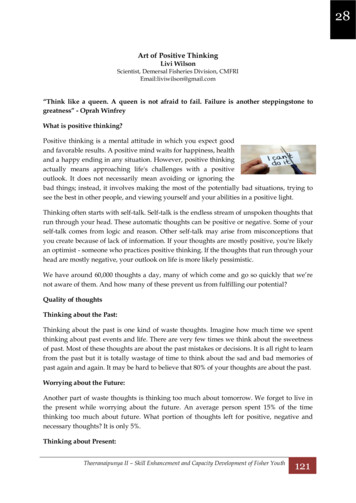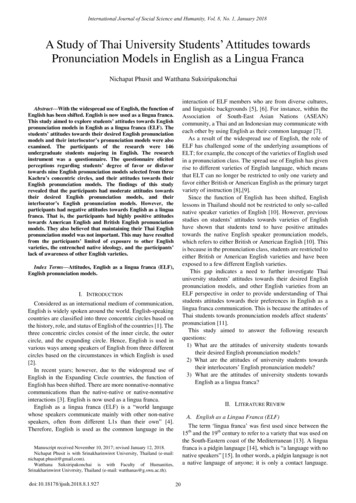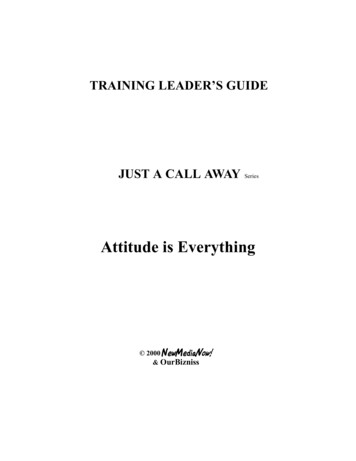
Transcription
ThePositive AttitudeDevelopmentWorkbookCorrectionalInstitution EditionAssimilating, Accommodating,Acclimating to Changedeveloped bywithLyle WildesJoe KellyWhole Person AssociatesDuluth, Minnesota
Whole Person Associates, Inc.210 West MichiganDuluth, MN 55802-1908 218-727-0500E-mail: books@wholeperson.comWeb site: http://www.wholeperson.comThe Positive Attitude Development WorkbookAssimilating, Accommodating, Acclimating to ChangeCorrectional Institution EditionCopyright 2009 by Lyle Wildes and Joe KellyNo part of this book may be reproduced or transmitted inany form by any means, electronic or mechanical, includingphotocopying, without permission in writing from the copyrightholders.Printed in the United States of America1098 7654321Editor: Peg JohnsonArt Director: Joy DeyLibrary of Congress Control Number: 2008940749ISBN-13 978-1-57025-229-7ISBN1-57025-229-7WHOLE PERSON ASSOCIATES210 West MichiganDuluth, MN 55802-1908
ContentsIntroductionsession 1:Awareness . . . . . . . . . . . . . . . . . . 9session 2:Thinking . . . . . . . . . . . . . . . . . . 19session 3:Trust. . . . . . . . . . . . . . . . . . . . . . 25session 4:In the Moment. . . . . . . . . . . . . 31session 5:Tenacity . . . . . . . . . . . . . . . . . . . 35session 6:Umbrella of My Emotions. . . 43session 7:Direction. . . . . . . . . . . . . . . . . . 51session 8:Esteem. . . . . . . . . . . . . . . . . . . . 57session 9:Sense . . . . . . . . . . . . . . . . . . . . . 65Afterword. . . . . . . . . . . . . . . . . . . . . . . . . . 77Worksheet Answers and Comments . . . . . . 79Acknowledgments . . . . . . . . . . . . . . . . . . 100
Dedicated to John and Lyn Clark Pegg
How to use this workbookThis workbook helps you learn the basicsof Positive Attitude Development (PAD). Youcan use it on your own or use it as a tool in aPAD group.The introduction gives you an overallsense of our perspective on Positive AttitudeDevelopment. The chapters are designedto be read and used in order, since eachchapter builds on concepts in the previouschapter(s).At the end of each chapter are BrainWorkactivities—mental exercises related to thesubject of the chapter. These exercises don’thave right or wrong answers—they aredesigned to get you thinking in new ways.When you come upon the BrainWorksymbol in the text, go to the end of thechapter and complete that particularBrainWork exercise. When you’ve completedthe exercise, go back to the text and keepreading.Once you’ve completed a chapter, turnto the back of the book to read somereflections on the chapter’s BrainWorkexercises. Don’t use the back of the book tofigure out how many answers you got right.Instead think about your responses in lightof the end-of-the-book reflections, and seewhat insights you gain.At first, some BrainWork questionsmay seem strange and difficult. That isintentional. Each question is meant torequire you to think differently. As youwork through each BrainWork, rememberthat Positive Attitude Development comesonly through daily repetition of powerfulmental exercises.In fact, we encourage you to use theBrainWork exercises over and over as youpractice and keep building your PositiveAttitude Development.We hope you enjoy your adventure.
I began to picture an attitude as the cloud from which our thoughts rain.Next, I imagined thoughts nourishing the soil from which our actions grow.And finally, I saw our actions blossoming into a positive, meaningful life.IntroductionAfter six months in the Milan, Michigan,federal prison, my daily pulse rate was 101beats per minute and I couldn’t get it toslow down. One day, as my table startedto shake, I was convinced there’d been anearly impossible event: a Magnitude Sixearthquake in Michigan.I felt I was falling out of my chair andlunged across the aisle to stabilize myself.Before my hand reached the other side, aninmate grabbed my arm and said, “Heydude, you better do something or you’renever going to make it out of prison alive.”At that moment, I realized I was in troubleand something had to give.Back then, I was convinced that everythingin my life would be okay if things outsideme (like other people and events) changed.If other people did what I thought theyshould do, then my stress would dissipate,peace would descend—and so would myheart rate. I was furious because thoseexternal stressors weren’t changing (orstaying the same) the way I wanted.The situation seemed much worse becauseI was locked behind a prison fence with noway to influence the outside world—and Iwas convinced that the external world wascausing all my pain. Everything just keptgetting worse, and I was in serious troublebecause it seemed like there was nothing Icould do to change the situation. If none ofthe events and people on the outside weregoing to change (in spite of my expectations,desires and demands), there was no way toreduce my stress and possibly save my life!I was at risk of dying for no medical reason.But what could I do? I was imprisoned bythe government and by my own stress, angerand anxiety.Of course, many other inmates were stressingout too. But I noticed some old timers wholooked very calm. They seemed capable ofdealing with losing everything they wereattached to—including control of their dailyactivities and any ability to influence outsidepeople and events.I started asking the old timers, “What do youknow that I don’t?” They simply said, “Youjust have to put your life on hold until youget out and then pick up whatever pieces areleft.” That sounded right, but it still didn’t
relieve the pain of seeing everything I wasattached to falling away. I was frozen in themoment of my arrest for drug dealing, whileeveryone else in my life was moving onward.It was at this point of my incarcerationthat a fellow prisoner, Dan L. Bayes, askedme to co-facilitate a positive attitude classthat aimed to teach other inmates how todeal with change. While wondering what Icould offer anyone about accepting change,this opportunity drove me to study theconnection between change and attitude.The experience eventually gave me a newlease on life, ultimately helping me to feelfree—even as I spent 18 more years behindbars. I realized the process for acceptingchange begins with one’s attitude. As Ienriched my own attitude I began to seeeverything, including my relationships,differently. This was huge!For more than 18 years, in cooperation withprison staff, I’ve taught this Positive AttitudeDevelopment course in federal prisons atthree security levels, each course running 20weeks or more. The programs have been wellreceived by inmates, with some taking thecourse multiple times.For those of us who adopted PAD, lifewas no longer a battle that we had to fightevery day. Even while we were restricted byincarceration, our lives became a journey.Instead of waiting for release to pick up thepieces, we began building a new life on theinside. This was the most freeing experienceof my life. I now had control over how I feltabout everything. My happiness was notbased on the way events happened (whetherwithin the prison or “on the outside”), butrather on the way I interpreted those events.I began to picture an attitude as the cloudfrom which our thoughts rain. Next, Iimagined thoughts nourishing the soil fromwhich our actions grow. And finally, I sawour actions blossoming into a positive,meaningful life.The texture and quality of our attitudedetermines the type of life we build forourselves. That’s the foundation of PositiveAttitude Development, which can offer thebeginning of a new life for each of us—nomatter what our circumstances.Lyle, your Positive Attitude Development course helped change my life.It taught me how to recognize my core values, how to look for the good inpeople and things, and how to see that my happiness does not depend on howpeople treat me—but on how I treat other people. This course was one of themost eye-opening, uplifting times in my life! Thank you so very much.Your friend forever,John Gelnette, former federal prisoner
22The Positive Attitude Development CourseYou stomp away fromthe phone, bump intoanother inmate, and spillhis food.You hang up thephone—a new trigger.She answersthe phone differentlythan usual.BrainWorkYou say, “I’m nothaving a good day.”A fight breaks out.You end up in specialdetention. The soundof handcuffs going“click.”“What’s that supposedto mean?”“I’m just tired.I went out with Maryand Bob last night.”He gets angry and yells,“You stupid idiot!”You hear the click of ofher hanging up—a newstimulus.“Hi. What’s the matter?”Example: Auto-Pilot Thinking“It’s time we deal withyour stupidity in thelaundry room.”“It’s not my fault yourold lady is going out withsomeone else!”“I’m tired of youquestioning me.”Do you stay onautomatic pilot or letgo and support herchoice?“Did he bring alongsomeone for you?”
to the back of the book to read some reflections on the chapter’s BrainWork exercises. Don’t use the back of the book to figure out how many answers you got right. Instead think about your responses in light of the end-of-the-book reflections, and see what insights you gain. At first,











